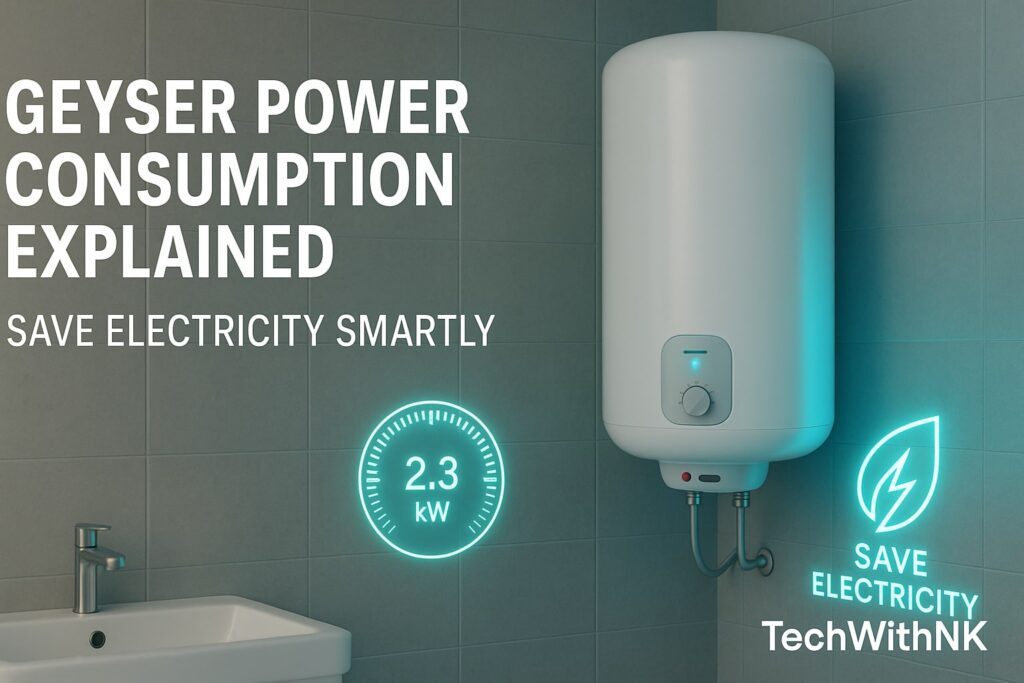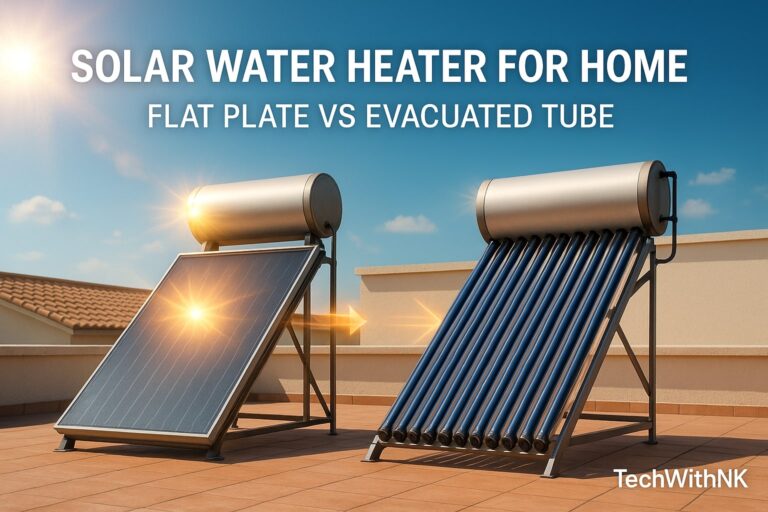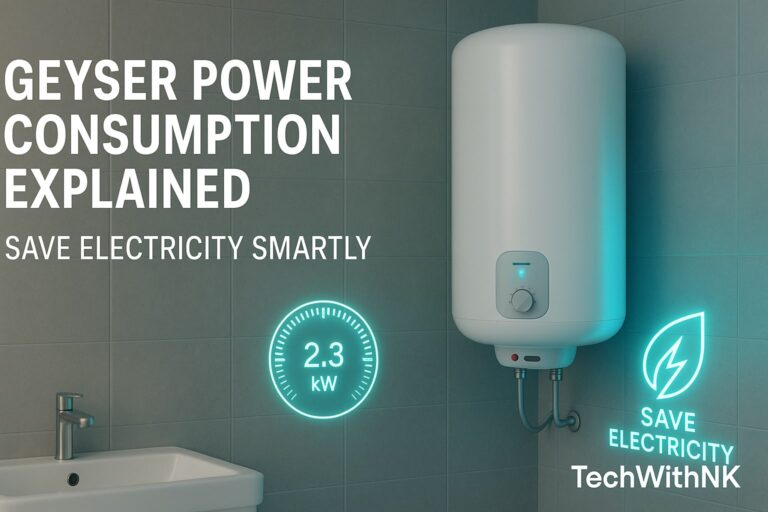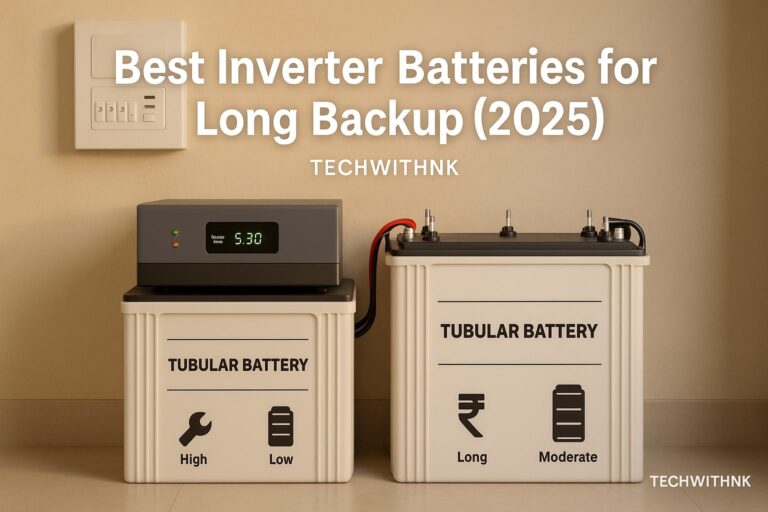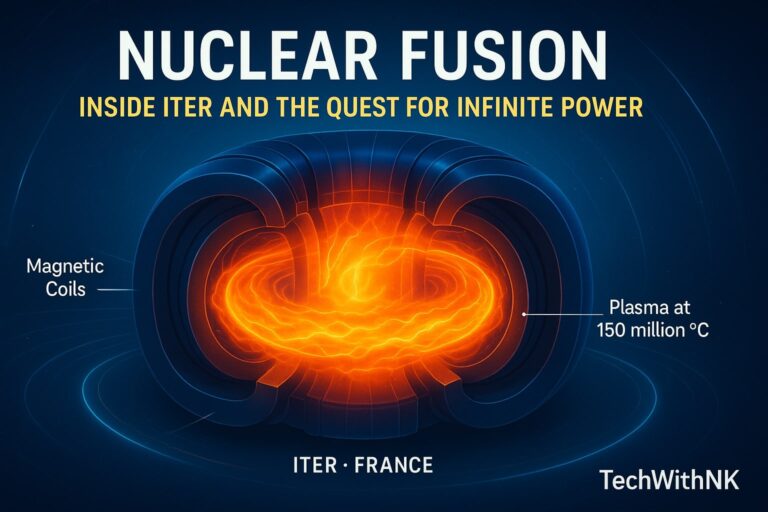Geyser Power Consumption Explained
Author: TechWithNK
Category: Home Appliances | Energy Efficiency
Estimated Reading Time: 15 minutes
Word Count: ~4200+
🏠 Introduction
A geyser or water heater is one of the most power-hungry appliances in Indian homes. Especially during winters, it becomes indispensable for daily bathing, washing, and kitchen use. But have you ever wondered how much electricity your geyser actually consumes and how to reduce your power bill without sacrificing comfort?
In this guide, we’ll break down everything you need to know about geyser power consumption, how wattage affects electricity usage, smart ways to save energy, and how modern smart geysers help you cut costs.
Let’s understand how you can save electricity smartly while staying warm.
⚙️ What Is Geyser Power Consumption?
Geyser power consumption refers to the amount of electrical energy used by your water heater to heat water to a desired temperature.
It depends mainly on:
Power rating (wattage) of the geyser
Heating time
Water quantity and inlet temperature
Usage pattern
Insulation efficiency
🔋 Typical Power Ratings of Geysers
| Type of Geyser | Capacity (Litres) | Wattage (Watts) | Usage Purpose |
|---|---|---|---|
| Instant Geyser | 1–3 L | 3000–4500 W | Kitchen or quick wash |
| Storage Geyser | 6–25 L | 2000–3000 W | Bathroom use |
| Gas Geyser | N/A | Uses LPG | Water heating without electricity |
| Solar Geyser | 100–300 L | Minimal electric backup | Entire household |
So, a 25-litre electric storage geyser generally consumes 2000–3000 watts per hour (2–3 kWh), depending on how long it operates.
🧮 How to Calculate Geyser Power Consumption
Let’s calculate it step by step.
🔸 Formula
Energy (kWh)==Power (W)×Time (hrs)/1000
🔸 Example
Suppose you use a 2 kW geyser for 1 hour daily.
2,000W×1h÷1000=2kWh/day
If your electricity rate is ₹8/kWh, then:
2×₹8=₹16/day
So, monthly:
₹16×30=₹480/month
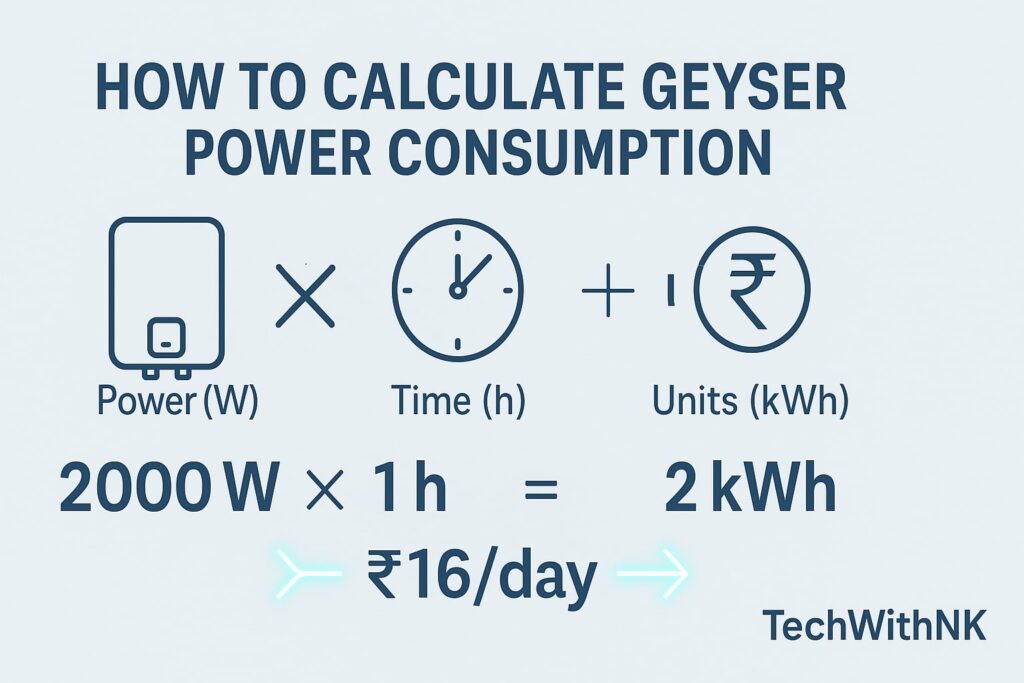
🔹 Realistic Daily Usage Scenario
| Usage Type | Daily Time | Energy Used (kWh) | Approx. Monthly Cost (₹ @ ₹8/unit) |
|---|---|---|---|
| Single person | 15–20 min | 0.5–1.0 | ₹120–₹240 |
| Family of 4 | 1–1.5 hrs total | 2–3 | ₹480–₹720 |
| Large family | 2–3 hrs | 4–6 | ₹960–₹1440 |
💡 Note: Most geysers automatically cut off when the water reaches the set temperature, reducing continuous consumption.
🌡️ Factors Affecting Geyser Power Consumption
Let’s explore the key factors that determine how much electricity your geyser uses.
1. Wattage of the Heating Element
A 3000 W geyser heats water faster but consumes more power per minute. A 2000 W model takes longer but uses less power in total.
👉 Higher wattage = faster heating, not necessarily higher monthly cost.
2. Water Quantity
Larger tanks (e.g., 25 L) require more energy to heat than smaller ones (e.g., 10 L).
3. Inlet Water Temperature
In winter, cold water (around 15°C) needs more heating than in summer (around 28°C). Hence, your electricity bill rises during colder months.
4. Insulation Quality
A well-insulated geyser retains heat longer, reducing reheating cycles.
💡 Look for PUF insulation and BEE Star Ratings for efficiency.
5. Thermostat Setting
Setting the thermostat to 75°C uses more power than 50°C.
For bathing, 50–55°C is usually sufficient.
6. Usage Pattern
Turning on the geyser much before bathing wastes electricity. Heat is lost during idle time.
✅ Use timer or smart plug to auto-switch ON/OFF.
7. Water Hardness
Hard water leads to scale formation on the heating element, reducing efficiency over time.
Regular descaling is necessary for consistent performance.
⚡ Power Consumption of Common Geyser Types
| Geyser Type | Average Wattage | Heating Time (25°C → 65°C) | Power Use (per session) | Electricity Cost (@₹8/unit) |
|---|---|---|---|---|
| 3 L Instant | 4500 W | 3–5 min | 0.25 kWh | ₹2 |
| 10 L Storage | 2000 W | 15–20 min | 0.6 kWh | ₹4.8 |
| 15 L Storage | 2000 W | 20–25 min | 0.8 kWh | ₹6.4 |
| 25 L Storage | 2000 W | 30–35 min | 1.0–1.2 kWh | ₹8–₹9.6 |
🌞 Comparison: Electric vs Solar vs Gas Geysers
| Type | Energy Source | Monthly Cost (Approx.) | Advantages | Drawbacks |
|---|---|---|---|---|
| Electric | Electricity | ₹500–₹1200 | Easy to install, consistent heating | High power cost |
| Solar | Sunlight (free) | ₹50–₹100 (for backup) | Renewable energy, eco-friendly | Expensive initial cost |
| Gas | LPG | ₹400–₹800 | Fast heating, portable | Safety & ventilation concerns |
👉 For long-term savings, solar water heaters are the best.
💡 Smart Tips to Reduce Geyser Power Consumption
Even small changes can significantly lower your electricity bill.
1. Switch Off After Use
Turn off the geyser immediately after heating. Continuous heating wastes energy due to thermal losses.
2. Use the Right Size
For a small family, 10–15 L geyser is sufficient. Oversized tanks waste power.
3. Insulate the Water Pipes
Cover hot-water pipes with foam insulation to retain heat for longer.
4. Use a Timer or Smart Plug
Install a smart plug or Wi-Fi timer to automatically control the geyser.
Example: Turn ON at 6:45 AM, OFF at 7:00 AM.
5. Maintain Moderate Temperature
Keep thermostat between 50–55°C. It’s enough for comfortable bathing and saves up to 20% power.
6. Avoid Reheating Multiple Times
Plan your family’s bathing time together so that reheating isn’t required multiple times a day.
7. Regular Maintenance
Clean heating element and tank annually to prevent scale deposits.
8. Use BEE 5-Star Rated Geysers
Energy-efficient models reduce electricity bills by up to 25%.
Look for brands like AO Smith, Havells, Bajaj, Crompton, Racold, Venus, and V-Guard.
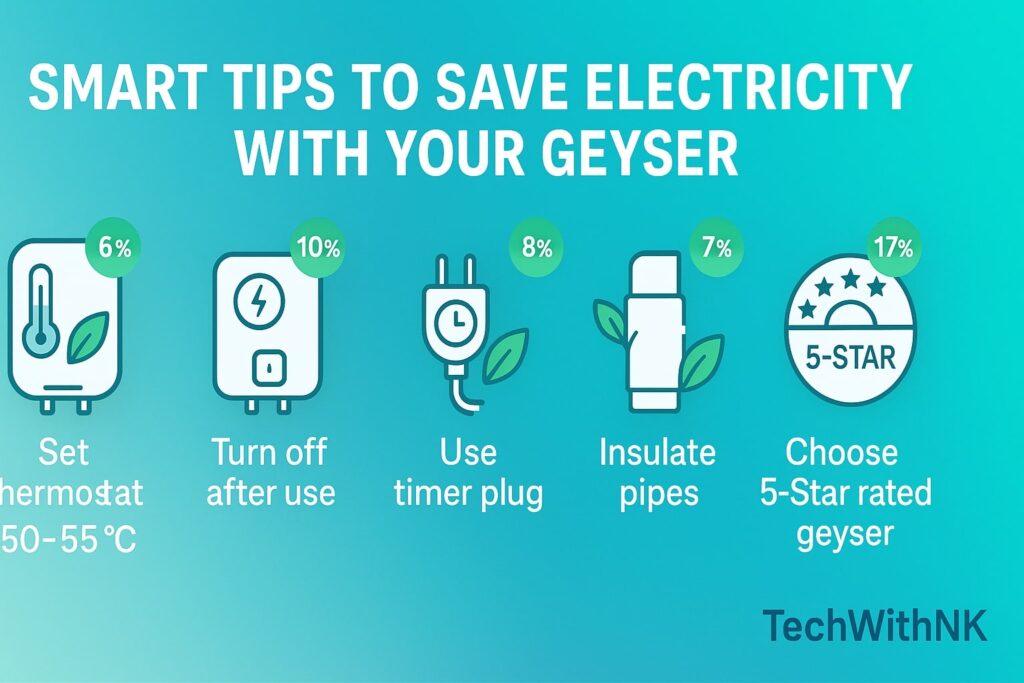
⚙️ BEE Star Ratings – What Do They Mean?
The Bureau of Energy Efficiency (BEE) in India rates appliances based on energy performance.
| Star Rating | Efficiency Level | Power Savings (approx.) |
|---|---|---|
| ★☆☆☆☆ | Low | Baseline |
| ★★☆☆☆ | Moderate | 10–15% |
| ★★★☆☆ | Good | 20–25% |
| ★★★★☆ | Very Good | 30–35% |
| ★★★★★ | Excellent | 40–50% |
A 5-star geyser may cost ₹1,000–₹1,500 more but pays back in a few months through reduced electricity bills.
🔌 Geyser Power Consumption vs Other Appliances
| Appliance | Power (W) | Daily Use (hrs) | Monthly Cost (₹ @ ₹8/unit) |
|---|---|---|---|
| Geyser | 2000 | 1 | ₹480 |
| Iron | 1000 | 0.5 | ₹120 |
| Washing Machine | 500 | 1 | ₹120 |
| Fridge | 150 | 24 | ₹864 |
| LED TV | 100 | 4 | ₹96 |
👉 Although geysers run for a short time, their high wattage makes them one of the top electricity consumers.
🔋 Smart Geysers: The Future of Energy Efficiency
Modern smart geysers come equipped with Wi-Fi control, temperature monitoring, and scheduling features.
🌐 Features of Smart Geysers
Remote control via mobile app
Auto-on/off timers
Energy usage tracking
Temperature control
Voice assistant compatibility (Alexa, Google Home)
🧠 Benefits
Prevent energy waste
Personalized heating schedule
Safety alerts and dry-heating protection
Real-time electricity consumption insights
Popular models:
🔸 AO Smith HeatBot i-series
🔸 Havells Adonia i-series
🔸 Bajaj Majesty Digital+
🌍 Solar Water Heaters – The Ultimate Saver
If your house receives sufficient sunlight, a solar geyser can cut up to 80–90% of your electricity bill.
✅ Benefits
Free solar energy
Long life (10–15 years)
Eco-friendly
Works with electric backup on cloudy days
Though initial investment (₹20,000–₹30,000) is higher, it’s ideal for long-term savings.
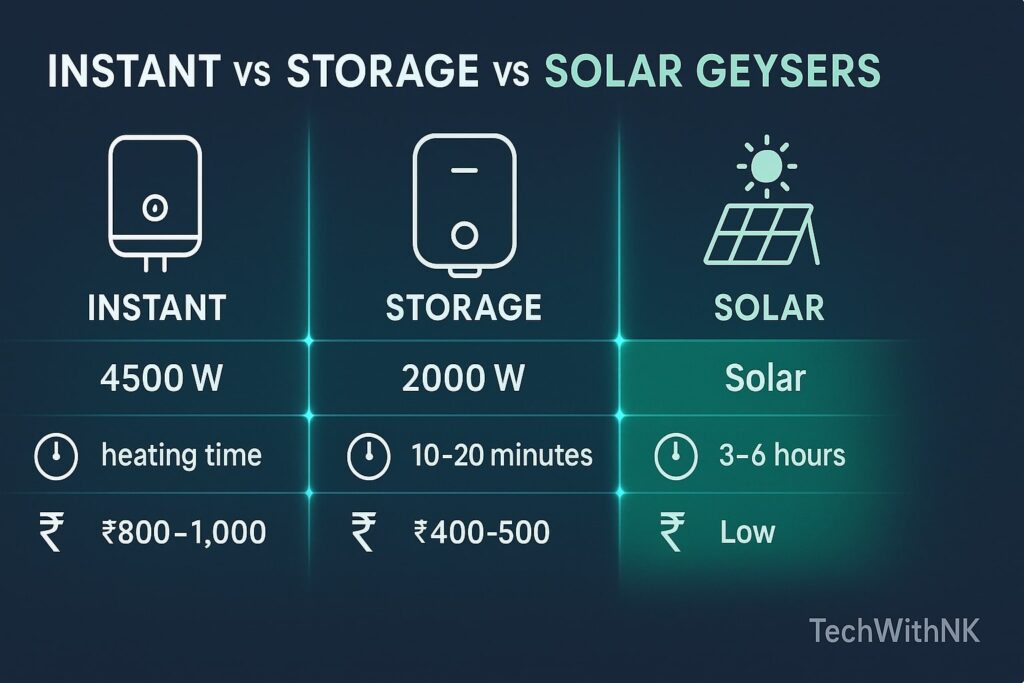
🧩 Myths vs Facts About Geyser Power Consumption Myth
| Myth | Fact |
|---|---|
| Leaving geyser ON keeps water hot and saves energy | ❌ It causes heat loss and wastes power |
| High-wattage geysers consume more electricity | ⚙️ Not always — they heat faster, so run for less time |
| Instant geysers are always cheaper | ⚖️ Instant geysers consume high power instantly but for short duration |
| Turning off the geyser immediately after use is unnecessary | ✅ It saves energy and extends life |
| Solar geysers don’t work in winter | ☀️ They work with electric backup during cloudy days |
🧭 Choosing the Right Geyser for Your Home
| mily Size | Recommended Capacity | Suggested Type |
|---|---|---|
| 1–2 persons | 3–6 L | Instant or small storage |
| 3–4 persons | 10–20 L | Storage type |
| 5+ persons | 20–35 L | Storage or solar |
| Kitchen use | 1–3 L | Instant |
Also, ensure ISI certification and BEE star rating for reliability and efficiency.
📉 Summary: How to Save Electricity Smartly
| Tips | Savings Potential |
|---|---|
| Set thermostat at 50–55°C | 20% |
| Switch off after use | 10% |
| Insulate pipes & tank | 15% |
| Use timer or smart plug | 10% |
| Group usage (family) | 10% |
| Regular maintenance | 5% |
Total potential saving: Up to 50% reduction in power consumption!
📢 Conclusion
Understanding geyser power consumption helps you make smarter decisions about usage, brand choice, and efficiency upgrades.
By adopting simple habits—like turning off after use, maintaining optimal temperature, and using star-rated models—you can easily cut your electricity bill by 30–50%.
In the long run, consider switching to smart geysers or solar water heaters for maximum savings and sustainability.
How many units does a geyser consume per hour?
A 2000 W geyser consumes 2 units (kWh) per hour of operation.
Is it OK to leave the geyser on all the time?
No. It wastes energy due to continuous heat loss and shortens lifespan.
What is the ideal temperature setting for a geyser?
What is the ideal temperature setting for a geyser?
